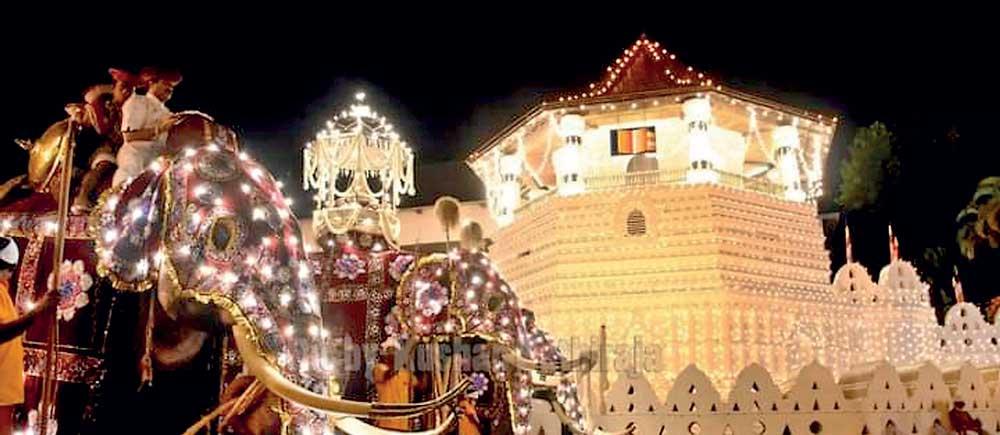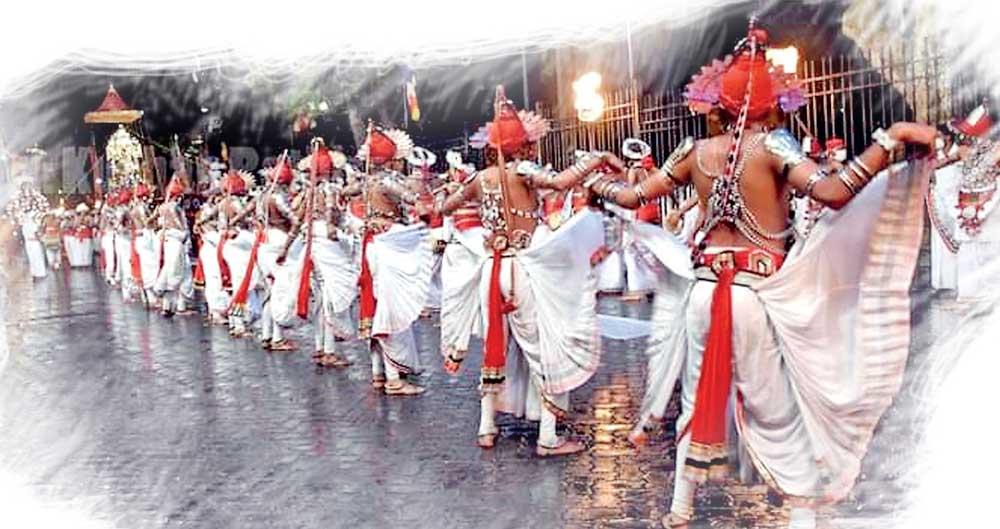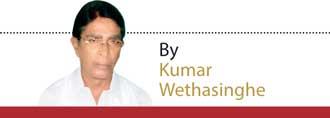Reply To:
Name - Reply Comment

Elephants adorned in glamorous and intricately designed costumes march through the streets of Kandy during the Esala Perahera

Kandyan dancers at the Esala Perahera
Photos by Kushan Pathiraja
 The historic Kandy Esala Perahera will parade the streets of the ancient Hill Capital, from August 10-20 this year. The procession will be conducted in line with traditional rituals, and will be headed by the Diyawadana Nilame of the Sri Dalada Maligawa, Nilanga Dela Bandara (Custodian) in association with the four Basnayake Nilames (Chief Custodians) of the four main devales (temples): Vishnu, Natha, Patthini and Kataragama.
The historic Kandy Esala Perahera will parade the streets of the ancient Hill Capital, from August 10-20 this year. The procession will be conducted in line with traditional rituals, and will be headed by the Diyawadana Nilame of the Sri Dalada Maligawa, Nilanga Dela Bandara (Custodian) in association with the four Basnayake Nilames (Chief Custodians) of the four main devales (temples): Vishnu, Natha, Patthini and Kataragama.
The glamorous pageant conducted in respect and honour of the sacred Tooth Relic of the Gautama Buddha brings safety, abundance and prosperity to the nation.
The parade, which was once banned by the British Governor, later became a state-sponsored event. The untimely epidemic had disturbed the holding of the historic pageant one year; however, following the ending of the epidemic, the Governor, with the advice of the Maha Sangha, decided to conduct the pageant every year.
Apart from the religious aspect, the pageant had gained international attention owing to its glamorous cultural performances and variety of entertainment.
In addition to banners and standards, the historic procession also features whip crackers, rhythmic drumbeaters, clarinet blowers, magnificent Kandyan dancers, torch bearers depicting the ancient styles. The most magnificent sight is undoubtedly the elephants and tuskers majestically marching through crowded streets, adorned in glamorous and intricately designed costumes.
This grand procession is an event that is eagerly looked forward to each year.
The origins of the Kandy Esala Perehera dates back to King Kithsiri Mevan (Megavanna) (301 – 328 BC). Time and again, state kings in India waged wars against each other to take procession of the Buddha’s Relics.
During the 4th Century B.C., King Guhashiva of Kalinga was in possession of a Sacred Tooth Relic of the Buddha. At the time, two powerful state princes declared war against King Guhashiva on the same issue. King Guhashiva, realising the impending threat, was determined to not surrender the Sacred Relics to enemies.
Accordingly, he entrusted his only daughter Princess Hemamali and Prince Dantha the responsibility of safeguarding the Sacred Relic from the enemy forces, in case they won the war.
King Guhashiva instructed them to be prepared and disguise themselves and escape to Sri Lanka. He wanted them to hand over the Sacred Relic King Kithsiri Mevan of Anuradhapura, as a royal gift from him.
Princes Hemamali and Prince Dantha’s Secret Mission
On hearing the demise of King Guhashiva and the defeat of the state, the duo gave up their royal regalia, disguised themselves as Brahmin pilgrims, and set forth to embark on their mission.
Princess Hemamali discreetly carried the tiny golden Relic Casket atop her head hidden within her knotted hair. Their task in espionage became gruesome and challenging. They had to walk through forests infested with wild beasts, and suffer thirst and hunger with no rest or sleep day and night. They could depend on none but their guardian deities.
As they crossed the borders of the jungle, they came across a sandy valley. Throughout the journey, the princess carried the Relic Casket on her head, safely hidden. They then took a brief rest and decided to make a pagoda of sand and hide the Relic Casket under it during their rest time.
While the couple was relaxing, a miracle occurred where beams of light illuminated from the Relic. An Arahant named Khema passing by above, noticed this splendour. He descended before the royal couple and listened to their noble mission. The Arahant paid his obeisance to the Buddha’s Relics and blessed the young couple to reach their destination successfully. He also advised them that in case they faced any disaster or obstacle to remember him.
Once again, Prince Dantha and Princess Hemamali went into deep sleep peacefully. Meanwhile, a powerful king cobra named Pandubhara, living by the banks of the Ganges River, witnessed the illuminations emitted from the sand pagoda. Being highly devotional, the Naga secretly removed the Relic Casket and vanished to the great Mountain ‘Mahameru’.
The royal couple, after waking up from their sleep, prepared to resume their journey and looked for the Golden Casket. Though the pagoda remained undisturbed, to their dismay, they realised that the Sacred Relic was missing. Disappointed by this sudden mischief, they prayed for Arahant Khema. The Arahant, not only arrived, but also traced the whereabouts of the Relic Casket.
Then, assuming the status of an Eagle, he went and confronted the powerful Naga. Naga, realising the spiritual powers of the Arahant, pleaded to allow him to retain the Sacred Relic to acquire more merits. The Arahant then addressed the Naga kindly and explained that more than a reptile having it, more merits would be generated by allowing the Relic Casket to reach the land of Sri Lanka, a meritorious nation capable of protecting, promulgating and preserving the doctrine of the Exalted One for the welfare of global society.
Pleased by the discovery, the couple carrying the Sacred Relic reached a safe naval city called “Tamalingamu”.
There, they were warmly welcomed by a large crowd who amply venerated by paying their deep obeisance to the Buddha’s Relic. The deities also offered perfume and flowers.
Delighted by the assurance received from the Arahant Khema, the royals reached the Indian shores and managed to hire a ship to sail to the island of Serendib.
As the vessel moved speedily, the sky was blue and the waves were conducive for the voyage. Amidst the band and music, the Prince and Princess performed poojas and offered alms to the Sacred Tooth Relic during their voyage.
Once again, they were obstructed by thousands of spiritually advancing Nagas as the reptiles of Naga Loka began to encircle the ship. When the reptiles began to venerate and worship, the Sacred Relic appeared in the sky for the benefit of all who wanted to pay their obeisance. Then, the joyful Nagas began to dance, paying their respect and obeisance when the ship came to a standstill.
Once again, by the interference of Arahant Khema, the mess was cleared and the ship reached its destiny turning golden pages in the history of Sri Lanka.
On their landing on Sri Lankan shores, Prince Dantha and Princess Hemamali remained as guests of a Brahmin at a Kovil. Thereafter, following the guidelines given by the Brahmin, the royal couple made their way towards the Capital city Anuradhapura. Travelling a long distance by foot through jungle paths, they arrived at Meghagiri Viharaya to meet the incumbent Thera.
The Maha Thera, having listened to the story of the royal visitors, dispatched an urgent message to King Kithsiri Mevan (Megavanna).
On hearing the welcoming news, the King became overjoyed and ordered immediate preparations to ceremonially welcome the royal visitors and to receive the precious royal gift.
At first King Kithsiri Mevan, listened to the detailed chain of events of the royal couple that made them bring the Sacred Relic in a manner of espionage. Having paid due respects and obeisance to the Buddha’s Relics, the King inquired as to why the Sacred Relic bore a tainted shade.
Dispelling all doubts, miraculously the Sacred Relic emerged from the casket appearing in the sky radiating a
luminous aura.
Thereafter, under Royal patronage, the city of Anuradhapura was gaily decorated, pandals were erected and conducted through a splendid pageant Princess Hemamali and Prince Dantha, along with the sacred Tooth Relic of the Gautama Buddha, were ushered to the King’s Palace. Upon reaching the royal yard, King Kithsiri Mevan went on his knees and carried the Sacred Relic on his head. He then placed the Sacred Golden Relic Casket on his royal throne, fully covered with jasmine flowers. Thereupon, the King made a vow offering the island of Serendib and the population of our nation the custody and protection of the holy and sacred Tooth Relic of the Buddha.
The King also made arrangements for the Princess and the Prince to permanently reside in Sri Lanka.
In response to the plea by the people, the King also ordered a public exposition of the Sacred Tooth Relic in Anuradhapura. Later, the Relic was placed at the Isurumuni and Dhamma Cakka Vihara, in a specially built chamber where offerings were made regularly.
After several years following foreign threats, the Relic was secretly moved to the mountain of Udundora, in Southern Sri Lanka.
During the reign of King Parakramabahu the Great, the Sacred Relic was brought back to the then Capital Polonnaruwa and was housed at the Dalada Maligawa.
Later, under different rulers, the Relic was transferred to several places and ruling cities. From Kotmale, King Vijayabahu III brought the Sacred Relic to Dambadeniya. It was then taken from Rajangana to Yapahuwa during the reign of King Bhuvanekabahu I. Thereafter, the Pandyans invaded the city and took away the Tooth Relic to their country, and King Parakramabahu III by diplomatic sources and friendly arrangements with Pandyan King Kulasekera, obtained the Sacred Relic and brought it back to Polonnaruwa. From Polonnaruwa, the Sacred Relic was taken to Dambadeniya, Yapahuwa, Kurunegala, Gampola and then Kotte.
During the Kotte disputes, the Sacred Relic was secretly taken to Delgamu Viharaya, Ratnapura and kept hidden.
King Vimaladharmasūriya of Kandy, having built the present Sri Dalada Maligawa, brought the Sacred Relic to Kandy in a grand religious parade. Then again, to protect the precious Relic it was periodically moved from place to place. The Sacred Relic was moved to Ududumbara, Kivulgama, Pitigoda, Hanguranketha, Kandenuwara, Kotmale and Puhulpitiya until it was permanently enshrined at the Sri Dalada Maligawa.
The Esala Perahera
During the initial stages of Kandyan Kings, processions and festivals were held to invoke the blessings of Gods Sri Vishnu, Kataragama, Natha and Patthini during the Esala season.
However, an era of religious renaissance was ushered in Sri Lanka during the reign of King Keerthi Sri Rajasinghe. At the time, most Ven. Asarana Sarana Saranankara Welivita Sri Sangaraja Mahathera of Malwatta Maha Viharaya Kandy, reestablished the higher ordination. Once the Devala Perahera went past the Sri Dalada Maligawa while the King and Maha Sangha were present at the occasion, the Upali Maha Thera of Siyam, proposed to the King that the Sri Dalada Perahera should lead such processions. Thus, the annual Kandy Esala Perahera was initiated by the King Kirthi Sri Rajasinghe, and is carried out to date.
However, when Ceylon became a British colony, under certain conditions the Relic was placed under their custody. Before long, the Mahasangha of the Asgiri and Malwatta Chapters became dissatisfied with the British rulers. Accordingly, in consultation with the Kandyan chieftains, the great National Patriot Most Ven. Wariyapola Sri Sumangala Maha Thera, who deflagged the Union Jack, took charge of the Tooth Relic and disappeared to the Dambulla forests. The British rulers, learning that the Maha Nayaka of Asgiriya, was in hiding with the Sacred Relic, imposed capital punishment on him and offered cash rewards for his capture, but nobody ever accepted the offer. Then, they arbitrarily jailed 40 members of the Maha Sangha for three years. Finally, following peace talks between the British and local heads, the differences were amicably settled. Thereafter, Ven. Wariyapola Mahanayake Thera returned to Kandy. Ever since, the Sacred Relic remained at the Sri Dalada Mandiraya Kandy.
Since the demise of the Buddha, the Relics of the Exalted One were distributed among the eight kings who reigned the Mahabharata during the day. They were removed under royal patronage with colourful flags and in ceremonial processions.